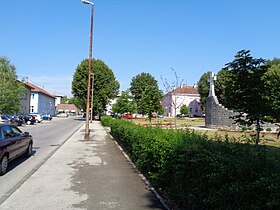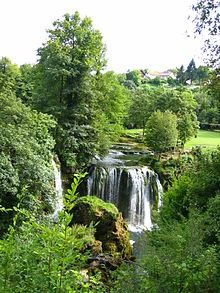Slunj
Slunj | |
|---|---|
| Grad Slunj Town of Slunj | |
 Zrinski Square in Slunj | |
 | |
| Coordinates:45°06′56″N15°35′05″E/ 45.11556°N 15.58472°E | |
| Country | |
| County | |
| Government | |
| • Mayor | Mirjana Puškarić (HDZ) |
| Area | |
| •Town | 393.4 km2(151.9 sq mi) |
| • Urban | 5.1 km2(2.0 sq mi) |
| Elevation | 258 m (846 ft) |
| Population (2021)[2] | |
| •Town | 4,224 |
| • Density | 11/km2(28/sq mi) |
| •Urban | 1,576 |
| • Urban density | 310/km2(800/sq mi) |
| Time zone | UTC+1(CET) |
| • Summer (DST) | UTC+2(CEST) |
| Area code | 047 |
| Website | slunj |

Slunj(HungarianSzluin,oldGermanSluin,LatinSlovin,archaicCroatianSlovin grad) is a town in the mountainous part of CentralCroatia,located along the important North-South route to theAdriatic SeabetweenKarlovacandPlitvice Lakes National Park,on the meeting of the riversKoranaandSlunjčica.Slunj has a population of 1,674, with a total of 5,076 people in the municipality (2011)[3]and is the cultural and social center of the region ofKordunin the vicinity toBosnia and Herzegovina.Administratively, the town is part ofKarlovac County.Slunj is an underdeveloped municipality which is statistically classified as part of theFirst Category Area of Special State Concernby theGovernment of Croatia.[4]
History[edit]
An old fortification of the Frankopans, built during the wars against theTurks,Slovinwas first mentioned in the 12th century. The old fort was property of theFrankopan(HungarianFrangepán) family since the 15th century, joined by an oldFranciscanmonastery from the same period. Later, this town has been called Slunj. In the 16th century the town was ravaged by theOttoman warsand turned into a military outpost of theCroatian Military Frontier,but by the end of the 17th century the settlement was rebuilt into the Slunj as it exists today. The castle has been developed to a fortress and served as headquarters for the commanding general of this area (seeStari grad Slunj). After theTreaty of Sistovain 1791 people increasingly began to re-settle in this area.
During the short French governance period from 1809 until 1813, Slunj encountered an economic boom as streets, storage facilities and mills were built and as vineyards and mulberry trees were planted. At this point of time, theCroatian languagehas become official language of the country. The residence of the former governor general of the French Illyrian Provinces, marshalAuguste de Marmont,still exists.
The town of Slunj was first mentioned in a written document by the chroniclerJohann Weikhard von Valvasorwho reported about the fortified town of Slunj, a bridge and a mill in 1689. The first illustration of the mills ofRastokedates back from 1789. It was a copper engraving that has been added to a description byBelsazar Hacquet.At the end of the 19th century,Stjepan Širolawrote the following about this place:"The surroundings of Slunj are downright romantic […]. They are crowned by the magnificent waterfalls of the Slunjčica river by which even not outspoken nature lovers will be captivated. Indeed, Slunj with its romantic surroundings and the silver waterfalls of the Slunjčica represent a true nature gem astonishing even to foreigners."
Until 1918, Slunj (namedSZLUIN[5]) was part of theAustrian monarchy(Kingdom of Croatia-Slavonia,Modruš-Rijeka County,after thecompromise of 1867), in theCroatian Military Frontier.[6]It was administered by theSZLUINER Grenz-Infanterie-Regiment N°IVbefore 1881. Slunj became a district capital in theModruš-Rijeka Countyin the Kingdom.
TheCazin uprisingof 1950, an armed anti-state rebellion of peasants, which mostly affected the Bosnian townsCazinandVelika Kladuša,also affected Slunj to a lesser extent. All of the cities were a part of Communist Yugoslavia at the time.[7]Peasants revolted against the forcedcollectivizationandcollective farmsby the Yugoslav government on the farmers of its country. Following a drought in 1949, the peasants of Yugoslavia were unable to meet unrealistic quotas set by their government and were punished. The revolt that followed the drought resulted in the killings and persecution of those who organized the uprising, but also many innocent civilians.[8][9]It was the only peasant rebellion in the history ofCold WarEurope.[10]

In 1963, the Austrian writerHeimito von Dodererpublished the novelThe Waterfalls of Slunj(German:Die Wasserfälle von Slunj) which features a climactic sequence set in this locality.[11]During the 20th century scientific research studies were carried out in the Slunj area and particularly its Rastoke district. During the 19th century and at the beginning of the 20th century Rastoke has been the center of social life in this region. With the development of the electric mill and massive emigration after the Second World War the economic significance of the mills in Rastoke has declined drastically.
Places of interest[edit]
Slunj is famous for its littlewaterfallsand the well-preserved cornmills(dating back to the 18th century) in the picturesque lower part of the town, calledRastoke(referring to the branching of the rivers). At Slunj, theSlunjčicariver (also called “Slušnica “by local people) flows over several waterfalls and cascades into theKoranariver. Here is also the location of the 22 water mills of Rastoke.
Population[edit]
As of 2011, most of Slunj's population is Croatian (87.9%) followed bySerbs(10.5%) and a small number of other ethnic groups.[12]
| population | 19430 | 19412 | 18110 | 20498 | 20724 | 21035 | 18749 | 21256 | 17004 | 16518 | 15798 | 13629 | 11799 | 10096 | 6096 | 5076 | 4224 |
| 1857 | 1869 | 1880 | 1890 | 1900 | 1910 | 1921 | 1931 | 1948 | 1953 | 1961 | 1971 | 1981 | 1991 | 2001 | 2011 | 2021 |
Settlements[edit]
Thesettlementsin the Town of Slunj is:[3]
- Arapovac,population 4
- Bandino Selo,population 6
- Blagaj,population 27
- Bukovac Perjasički,population 3
- Crno Vrelo,population 7
- Cvijanović Brdo,population 2
- Cvitović,population 279
- Čamerovac,population 57
- Donja Glina,population 28
- Donja Visočka,population 9
- Donje Primišlje,population 35
- Donje Taborište,population 200
- Donji Cerovac,population 129
- Donji Furjan,population 59
- Donji Kremen,population 47
- Donji Lađevac,population 46
- Donji Nikšić,population 204
- Donji Poloj,population 11
- Donji Popovac,population 20
- Dubrave,population 21
- Glinsko Vrelo,population 43
- Gornja Glina,population 144
- Gornja Visočka,population 16
- Gornje Primišlje,population 13
- Gornje Taborište,population 227
- Gornji Cerovac,population 94
- Gornji Furjan,population 85
- Gornji Kremen,population 65
- Gornji Lađevac,population 58
- Gornji Nikšić,population 47
- Gornji Popovac,population 176
- Grobnik,population 20
- Jame,population 28
- Klanac Perjasički,population 6
- Kosa,population 15
- Kosijer Selo,population 5
- Kutanja,population 2
- Kuzma Perjasička,population 11
- Lađevačko Selište,population 11
- Lapovac,population 35
- Lumbardenik,population 141
- Mali Vuković,population 115
- Marindolsko Brdo,population 59
- Miljevac,population 10
- Mjesto Primišlje,population 49
- Novo Selo,population 68
- Pavlovac,population 35
- Podmelnica,population 199
- Polje,population 29
- Rabinja,population 0
- Rastoke,population 50
- Salopek Luke,population 17
- Sastavak,population 14
- Slunj,population 1,674
- Slunjčica,population 7
- Snos,population 8
- Sparednjak,population 3
- Stojmerić,population 3
- Šlivnjak,population 17
- Točak,population 70
- Tržić Primišljanski,population 20
- Veljun,population 112
- Veljunska Glina,population 17
- Veljunski Ponorac,population 12
- Videkić Selo,population 21
- Zapoljak,population 8
- Zečev Varoš,population 23
Sport[edit]
Football[edit]
Although Slunj is very small, it has many sport clubs. Most famous are the football clubNK SlunjandMNK Drenak.There are two football fields in Slunj. One is situated in the center of Slunj and popularly calledGradsko igralište(Town field) and the other is Zubac, which is the official turf of NK Slunj.
Koranski susreti[edit]
On the last day of"Dani grada Slunja"(festivity calledDays of the city of Slunj), which usually takes place at the beginning of August, games are organized on main swimming area on the river Korana. Participating teams compete in many games like swimming and snorkeling and many other.
Notable people[edit]
- Milan Neralić(famous fencer and winner of the Bronze Medal at the Olympic Summer Games in Paris in 1900
Acknowledgements[edit]
Twin towns[edit]
 Castel San Giovanni,Italy
Castel San Giovanni,Italy Grude,Bosnia and Herzegovina
Grude,Bosnia and Herzegovina
Mississauga,Canada
See also[edit]
Gallery[edit]
-
Park in the town center
-
Christmas decorations in Slunj
-
Houses in Rastoke
-
Korana Bridge
-
WarehousefromNapoleonictimes
-
View of Rastoke
-
In front of the "Buk" department store.
-
Brothers Radić Street
-
Memorial to fallen defenders and civil victims of theCroatian War of Independence
References[edit]
- ^Register of spatial units of the State Geodetic Administration of the Republic of Croatia.WikidataQ119585703.
- ^"Population by Age and Sex, by Settlements"(xlsx).Census of Population, Households and Dwellings in 2021.Zagreb:Croatian Bureau of Statistics.2022.
- ^ab"Population by Age and Sex, by Settlements, 2011 Census: Slunj".Census of Population, Households and Dwellings 2011.Zagreb:Croatian Bureau of Statistics.December 2012.
- ^Lovrinčević, Željko; Davor, Mikulić; Budak, Jelena (June 2004)."AREAS OF SPECIAL STATE CONCERN IN CROATIA- REGIONAL DEVELOPMENT DIFFERENCES AND THE DEMOGRAPHIC AND EDUCATIONAL CHARACTERISTICS".Ekonomski pregled, Vol.55 No.5-6.Retrieved25 August2018.
- ^Name of the Austrian post-office opened in 1864.
- ^Handbook of Austria and Lombardy-Venetia Cancellations on the Postage Stamp Issues 1850-1864, by Edwin MUELLER, 1961.
- ^"CAZINSKA BUNA 1950: Danas se navršavaju 62 godine od ustanka u Krajini".Cazin. 6 May 2012. Archived fromthe originalon 9 June 2012.Retrieved11 February2014.
- ^"Klanjana kolektivna dženaza žrtvama Cazinske bune iz 1950. godine".Haber. 11 May 2012. Archived fromthe originalon 22 February 2014.Retrieved11 February2014.
- ^"Vera Kržišnik Bukić i Cazinska buna".Radio Sarajevo. 4 May 2012. Archived fromthe originalon 22 February 2014.Retrieved11 February2014.
- ^Mueller, Andrew (2010).Rock and Hard Places: Travels to Backstages, Frontlines and Assorted Sideshows.ISBN9781593763794.Retrieved11 February2014.[permanent dead link]
- ^Doderer Gesellschaft. Heimito von Doderer. Die Wasserfälle von Slunj.
- ^"Population by Ethnicity, by Towns/Municipalities, 2011 Census: County of Karlovac".Census of Population, Households and Dwellings 2011.Zagreb:Croatian Bureau of Statistics.December 2012.
- ^"World recognition for the Croatian town of Slunj".croatiaweek.com.Croatia Week. 23 October 2023.Retrieved23 October2023.
This articleneeds additional citations forverification.(January 2009) |











